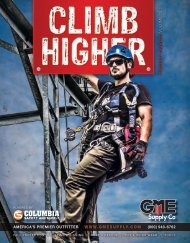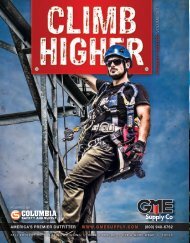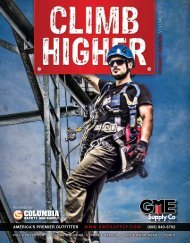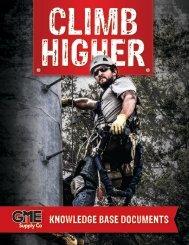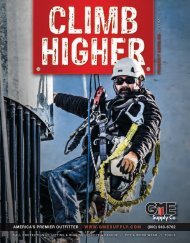GME Supply Product Catalog Version 17.3
GME Supply is North America's premier outfitter of fall protection, safety equipment, and gear for at-height workers, industry, and construction.
GME Supply is North America's premier outfitter of fall protection, safety equipment, and gear for at-height workers, industry, and construction.
Create successful ePaper yourself
Turn your PDF publications into a flip-book with our unique Google optimized e-Paper software.
ROPE 101<br />
Rope Construction<br />
Kernmantle (Pages 68-69) - Kernmantle rope consists<br />
of twisted parallel fibers (the kern) surrounded by a tightly<br />
braided sheath (the mantle). The core fibers provide the<br />
majority (about 70%) of the rope’s strength. The sheath<br />
is tightly braided providing significantly higher abrasion<br />
resistance. There are two distinct types of kernmantle: dynamic<br />
and static. Dynamic is used for recreational climbing due to its<br />
high shock absorption capabilities. Static kernmantle has very<br />
low stretch and works well for industrial applications. Due<br />
to its construction, it remains round through descent devices<br />
and allows minimal twist on the rope. The properties of static<br />
kernmantle make it ideal for use as a life line or descent line.<br />
3-Strand (Page 71) - 3-Strand ropes are an inexpensive<br />
rope option. They tend to have a lower breaking strength than<br />
double braid or kernmantle, so a larger diameter must be<br />
used to achieve the same strength. Due to their construction,<br />
3-Strand ropes have a tendency to rotate under load and<br />
provide less abrasion resistance. These characteristics<br />
make it a poor load line. With regard to safety and working<br />
at height, 3-Strand is most commonly used as a lifeline due<br />
to compliance with OSHA requirements and compatibility with<br />
5/8” rope grabs.<br />
Diameter<br />
As ropes get thicker, they get stronger. But there’s a<br />
misconception that to be as safe as possible you should get<br />
the thickest rope available. In reality, your rigging is only as<br />
strong as your weakest component. The capstan, shackles,<br />
slings, blocks, and rope all must be considered. If you’re using<br />
a 1,000 pound capstan hoist, most 1/2” Double Braids have<br />
an MBS high enough to safely handle the maximum load for<br />
the hoist; even with the safety factor, and any loss of strength<br />
due to knots, termination plates, or sewn eyes. While a 5/8”<br />
rope has a higher breaking strength, it would not matter since<br />
the hoist is only capable of lifting 1,000 pounds. Another thing<br />
to consider is the sheave diameter of the blocks being used.<br />
There are many options which can handle 1/2” synthetic rope,<br />
but few exist that are strong enough to justify 5/8” rope.<br />
Inspection<br />
Each time you use your rope, you should perform a visual<br />
inspection to ensure it’s safe to use. Check for cuts, nicks,<br />
burns, excess fraying, flat or uneven spots, burns, harness,<br />
glossing, discoloration from sun exposure or chemicals,<br />
or inconsistencies in the rope. Refer to the manufacturers<br />
recommendations for complete inspection and usage<br />
instructions. Use a rope log, like the one available on<br />
www.gmesupply.com/knowledge-base to keep a complete<br />
record of inspections.<br />
Another practice which is becoming more common is<br />
individual serial numbers for rope. This permanent label is<br />
useful to document when a rope goes into service, as well<br />
as track inspections.<br />
Have additional rope questions?<br />
Give our Gear Experts ® a call!<br />
ROPE<br />
DIAMETERS<br />
6 mm<br />
7 mm<br />
8 mm<br />
9 mm<br />
10 mm<br />
11 mm<br />
12 mm<br />
13 mm<br />
14 mm<br />
15 mm<br />
16 mm<br />
5/16”<br />
3/8”<br />
7/16”<br />
1/2”<br />
5/8”<br />
Double Braid (Page 100) - Double braided rope is, as<br />
the name implies, a braided core surrounded by a braided<br />
sheath. The inner and outer braids are generally designed<br />
to share the load equally with very low elongation. Double<br />
braid rope remains round under tension, imparts no<br />
rotational force when loaded and has a soft hand.<br />
These characteristics make it ideal for use as a load<br />
rope.<br />
17 mm<br />
18 mm<br />
19 mm<br />
3/4”<br />
(800) 940-6762<br />
67












